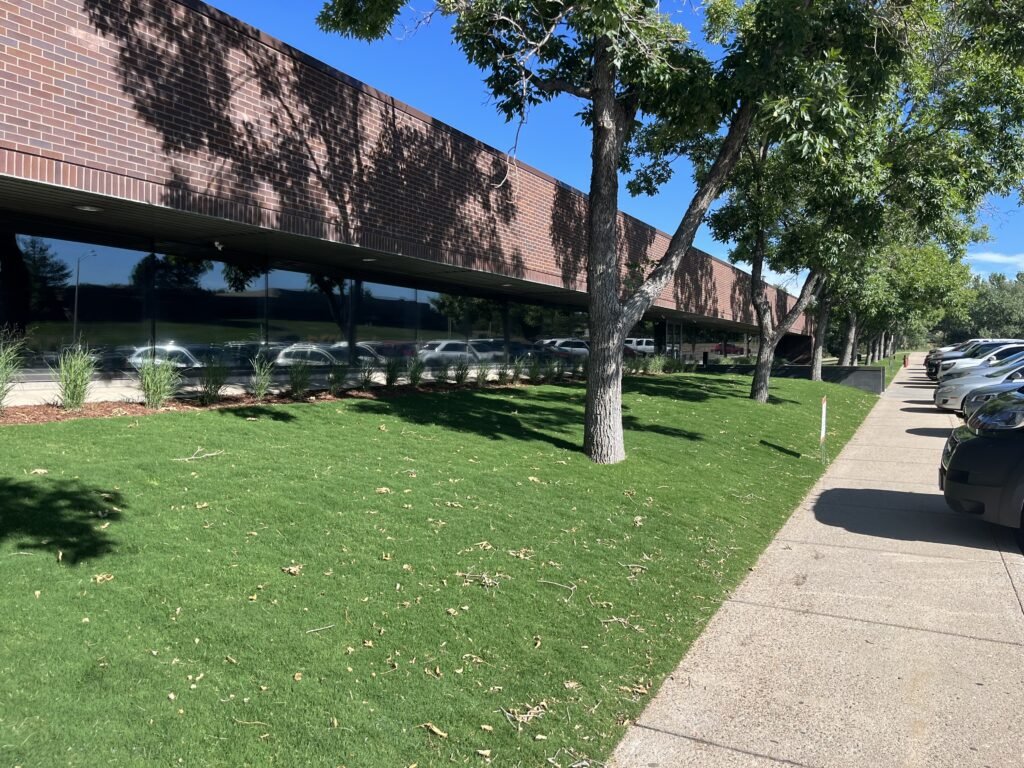Case Study: PPLD 21c Landscape Conversion
As water becomes scarcer in Colorado, one significant area of potential water savings is the reduction of outdoor water usage, particularly the use of turfgrass such as Kentucky Bluegrass. Although Kentucky Bluegrass has traditionally been the dominant choice for lawns in residential and commercial properties, it is now under scrutiny due to its high water requirements. Maintaining a lush Kentucky Bluegrass lawn typically demands around 40 inches of water. In areas like Colorado Springs, where annual rainfall is only about 15 inches, an additional 25 inches of irrigation is needed to sustain Kentucky Bluegrass.
Turf conversions from high water use grass to low water use alternatives are becoming increasingly common, especially in areas with non-functional or infrequently used turf. The phrase “if the only time you step on the turf is when you mow it” can be used to assess whether the turf is functional or not. Non-functional turf areas are often the first to be considered for conversion.
Pikes Peak Library District in Colorado Springs selected Library 21c as a test site for such a conversion. They collaborated with Carla Anderson, PLA, ASLA to design the project, and Fisk Lawnscapes completed the installation. Colorado Springs Utilities provided rebates for both irrigation and native conversions. Over an acre of Kentucky Bluegrass was transformed into several varieties of grass:
Varieties:
7,200 sqft of “Tahoma 31” Bermudagrass (experimental for Colorado Springs)
30,000 sqft Native Prairie Mix
13,100 sqft Western Wheatgrass interspersed with Russian Sage
4,350 sqft Western Wheatgrass in a “pure stand”
3,900 sqft Prairie Sandreed & Side Oats Grama Mix
The primary aim of this conversion was to promote sustainability, reduce maintenance and water costs, and serve as an example of the beauty and viability of a well-maintained native, low water use landscape.
For more information on the conversion process, please check out our blog post about native conversions. Additionally, consider reviewing the Colorado Native and Waterwise Grass Guide as you plan your own conversion.
Challenges:
Small spaces, like those between a rock or mulch bed and a curb, can pose challenges for seeding and irrigation. Additional effort is required to establish seeds in such limited areas.
Shade can significantly impact germination rates, even in areas with “moderate” sun exposure. Extra patience and additional seed may be necessary for shaded areas, and some may be better suited for alternative landscaping if germination proves difficult.
Despite best seeding practices, heavy rain and hail storms can disrupt germination. Plan for some areas to wash out and require reseeding. Planting seeds half an inch underground can help resist washout.
For seeding native grasses, the ideal germination timeline is relatively short (June – August). Ensure that your Request for Proposal (RFP) allows sufficient time for bidding, planning, and irrigation retrofits before seeding begins, so there’s enough time for the seeds to establish and grow sufficiently to withstand winter.
Tahoma 31 Bermudagrass experienced significant winter kill in Colorado sod farms, necessitating the purchase of this grass from out of state and having it shipped to meet the project’s timeline.
Other aspects of the project include:
Removing junipers and installing ornamental grasses.
Converting un-irrigated parkway strips to rock.
Adding a breeze walkway.
Map of Project Scope
Project Collaborators:
Carla Anderson, PLA, ASLA
Project Progression:
June 2 – Work began
Initial Modifications to the site
Modified irrigation zones, added lateral lines to improve coverage, and converted sprinkler heads to pressure reducing, check valve spray heads with MP rotator nozzles
First application of herbicides to kill existing bluegrass (See Photos Below)
June 19 – Second application of herbicides to kill existing bluegrass
July 3 – Spot application of herbicides to kill any remaining bluegrass or weeds that had popped up
July 21 – Installation of Tahoma 31 (See Photos Below)
July 27 – Seeding Native Areas & Fertilizer Applied
Seed installed at approx. 3lbs/1000sqft
Notes on weather conditions – we had several hard rain & hail storms the 2 weeks after seeding. This made for some nervous biting of nails while the seed came in, and some erosion cleanup. This also washed out some seed in a couple areas.
Aug 8 – Seed Germination (See Week 1.5 photos)
Aug 15 – See Week 2.5 Photos Below
Aug 22 – First weed control application – Quicksilver & Confront
Aug 29 – See Week 4 Photos Below
Sept 25 – See Week 8 Photos Below
Landscape Progress Photos







Before Pictures – taken just after first herbicide application



Tahoma 31 Installation




Approximately 1.5 weeks after seeding – first germination

















Approximately 2.5 weeks after seeding











Approximately 4 weeks after seeding – after first weed control application















Approximately 8 weeks after seeding
View our update on this landscape conversion as we look toward Season 2, when the native is fully established and filled in!








